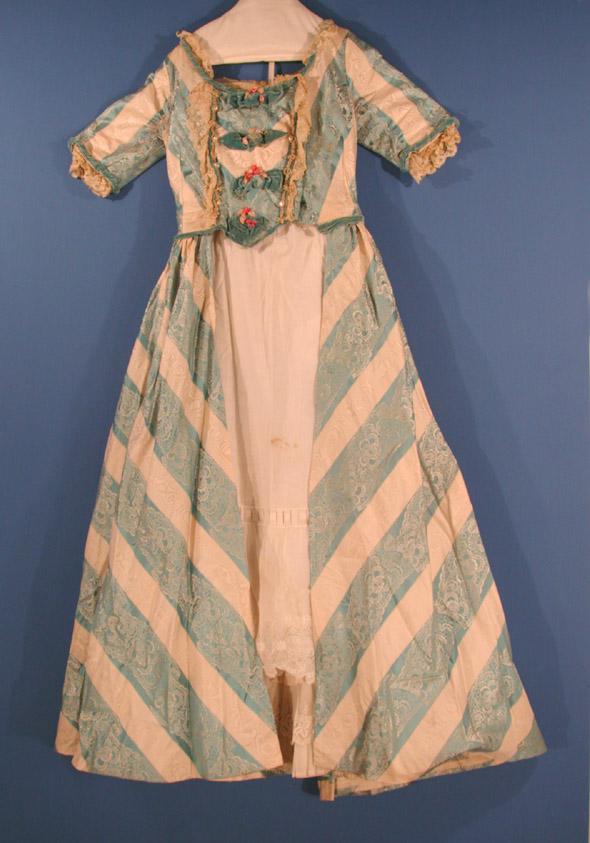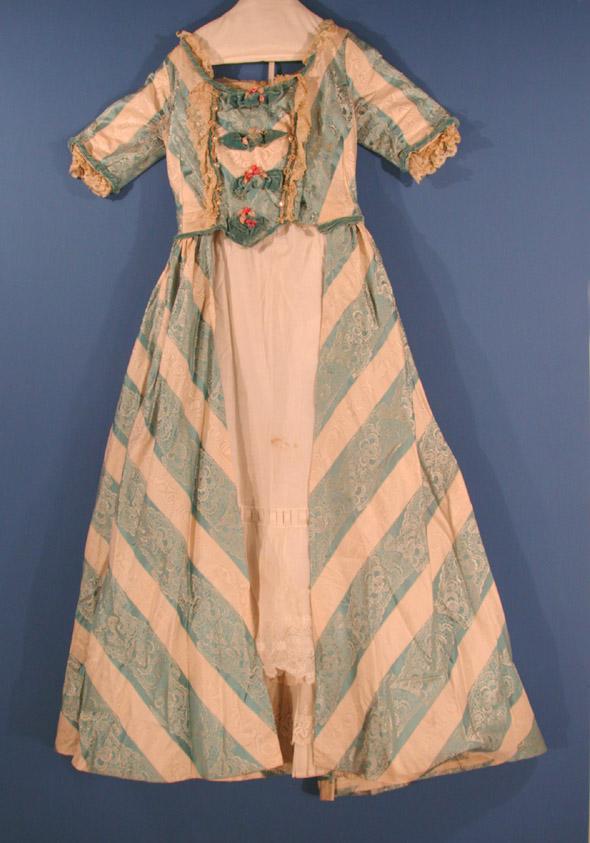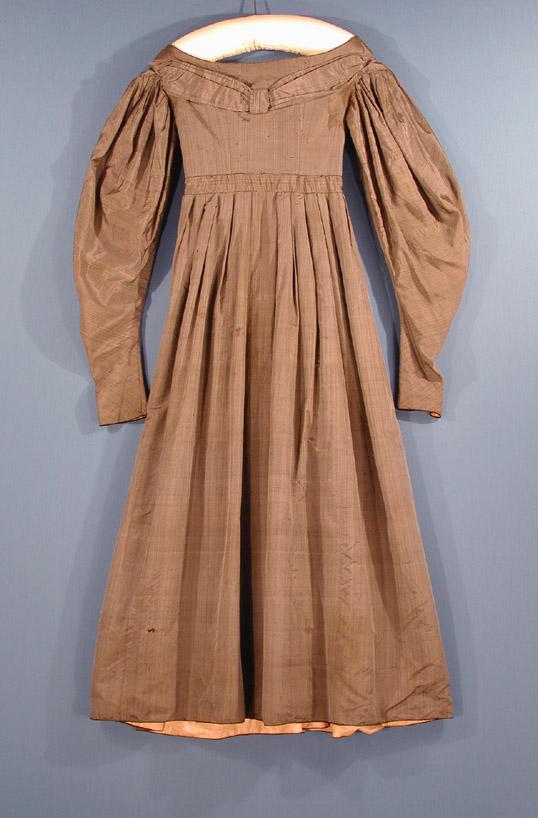Dress and Two Petticoats
Clothing MakerMade by
Unknown
Dateabout 1905-1915
MediumDress (.a): Machine-stitched silk and cotton, cotton hand-stitched lace, faux pearls, silk and wire flowers, metal hooks and eyes.
Petticoat (.b): Machine-stitched cotton and linen, with machine-made cotton needlerun lace, and a mother of pearl button.
Under Petticoat (.c): Machine-stitched cotton.
DimensionsComponent (dress length x width across shoulders): 53 1/2 x 14in. (135.9 x 35.6cm)
Component (dress petticoat length): 37 1/2in. (95.3cm)
Component (under petticoat hem circumference x length): 89 x 34in. (226.1 x 86.4cm)
ClassificationsCostume
Credit LineGift of the University of Connecticut Health Center Auxiliary Thrift Shop
Object number2002.57.1a-c
DescriptionWoman's colonial revival costume, consisting of an open-fronted gown (.a) and two petticoats (.b and .c). The dress is made of silk brocade fabric woven to simulate alternating ribbons, one a picot-edged, cream-colored moire, the other a turquoise color, woven with a lace design in a cream color. The neckline is square and edged with a strip of turquoise velvet twisted to simulate cording. Inside the neck edge is stitched a trimming of coarse, handmade bobbin type lace applied over net. The dress has a faux stomacher front decorated with bows of turquoise velvet and pink silk flowers. It is edged on the sides with lace and a trimming of faux pearls sewn along a strip of turquoise velvet. The "stomacher" is cut on the bias and seamed down the center to create a V-effect with the fabric stripes. The bodice is fitted with darts in the front. (The current dart on the proper left side is not in its original position, but set slightly to the left. The darts in the back have also been moved.) The elbow-length sleeves are tight and edged around the opening with velvet cording and a ruffle of lace. The bottom of the dress bodice is also edged with the velvet cording. The dress originally opened down the center back and fastened with hooks and eyes; this has been hand-stitched closed and a new opening created on the proper left side of the bodice stomacher, which fastens with one metal snap and three hooks and eyes. The bodice is lined with plain cotton. A strip of white cotton encircles the waist like a petersham; the safety pin which was used to close it was removed at the time of cataloguing.
The skirt of the dress has an open front so that the fancy petticoat might be seen. The fabric is stitched on the bias so that the stripes run diagonally. The skirt is gathered to the bottom edge of the bodice. The fullness of the skirt is controlled by a cotton twill tape stitched at intervals across the inside of the skirt, seven inches below the waist. The front edges of the skirt are lined with light blue cotton. A flat, decorative self-fabric bow stitched to the center back of the dress at the waistline is part of the later (probably 1950s) alteration of this colonial costume.
The petticoat (.b) meant to show under the dress is decorated with tiers of needlerun net lace over the plain, white cotton. The top four rows of lace cover only the front of the petticoat; the next five rows extend around the sides but do not continue across the back, and the last row of lace continues all around the skirt. Around the hem of the petticoat, extending below the lace, is a self-fabric pleated ruffle. The center back panel of the petticoat has a flounce of netting, stitched at about knee-height. The center back opening extends eleven inches and fastens with a single mother of pearl button at the waistband, which is 1 1/8 inch wide and is made of plain-woven linen.
The under petticoat (.c) has a drawstring waistline; the casing is made by stitching a cotton twill tape along the inside waist edge. The petticoat is gored for fullness and there is a 10 1/2-inch-deep machine-embroidered whitework flounce around the bottom, headed by a 1 1/4-inch-wide strip of whitework insertion, which would have had a ribbon woven through it. Under this wide flounce is a 4 1/4-inch-deep scalloped flounce.
The skirt of the dress has an open front so that the fancy petticoat might be seen. The fabric is stitched on the bias so that the stripes run diagonally. The skirt is gathered to the bottom edge of the bodice. The fullness of the skirt is controlled by a cotton twill tape stitched at intervals across the inside of the skirt, seven inches below the waist. The front edges of the skirt are lined with light blue cotton. A flat, decorative self-fabric bow stitched to the center back of the dress at the waistline is part of the later (probably 1950s) alteration of this colonial costume.
The petticoat (.b) meant to show under the dress is decorated with tiers of needlerun net lace over the plain, white cotton. The top four rows of lace cover only the front of the petticoat; the next five rows extend around the sides but do not continue across the back, and the last row of lace continues all around the skirt. Around the hem of the petticoat, extending below the lace, is a self-fabric pleated ruffle. The center back panel of the petticoat has a flounce of netting, stitched at about knee-height. The center back opening extends eleven inches and fastens with a single mother of pearl button at the waistband, which is 1 1/8 inch wide and is made of plain-woven linen.
The under petticoat (.c) has a drawstring waistline; the casing is made by stitching a cotton twill tape along the inside waist edge. The petticoat is gored for fullness and there is a 10 1/2-inch-deep machine-embroidered whitework flounce around the bottom, headed by a 1 1/4-inch-wide strip of whitework insertion, which would have had a ribbon woven through it. Under this wide flounce is a 4 1/4-inch-deep scalloped flounce.
Status
Not on view













